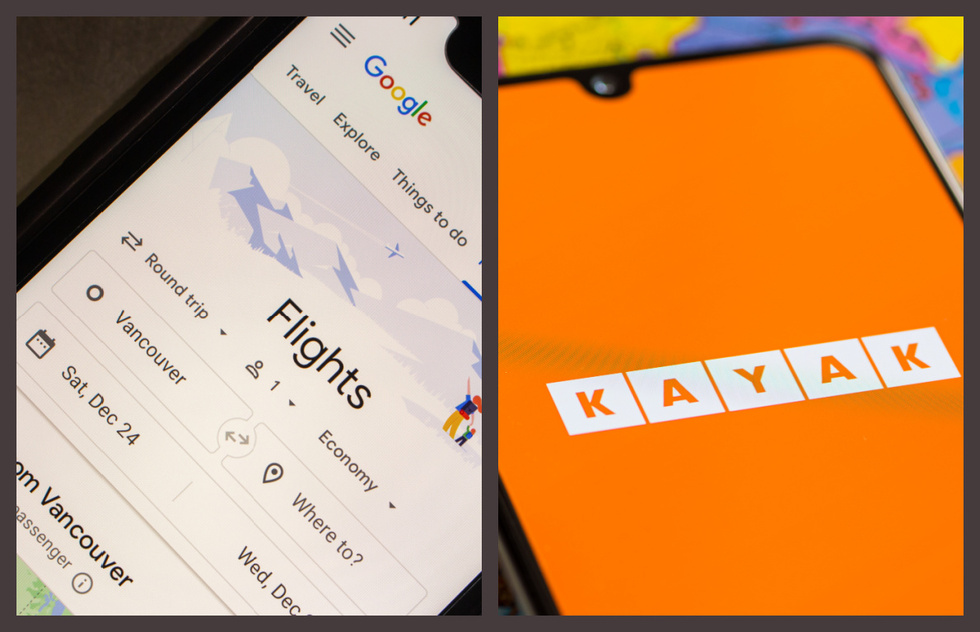This article was updated with new information on September 14, 2023.
There’s no shortage of advice out there on when you should book a flight. Analysts and experts have addressed everything from the age-old question of whether there’s a best day of the week to search to the matter of choosing the cheapest day of the week to fly (hint: try the middle of the week).
Recently, though, some new online tools have emerged that purport to get a lot more specific, personalizing suggestions on whether you should book your desired flight itinerary now or wait for a time when prices are expected to be lower.
Just a few weeks ago, Google added such a feature to its Google Flights portal.
The site, which already allows users to quickly search for flights and prices across many airlines—and even buy tickets if those users want to—now aims to answer a new question: When should you take the plunge and book?
The tool is somewhat similar to something rolled out in June by online travel platform Kayak, which claims to help users find the cheapest airfare by, among other things, advising customers whether to book right away or wait until later.
We tried out both tools. Here’s how they work.
Google Flights' new tool for finding the cheapest time to book
For some time now, Google Flights has had a function that tells you, essentially, whether you’re getting a good deal or not as you consider a flight.
When you select an itinerary, the feature reveals whether your airfare is high, low, or typical for that route and date, based on data trends over time.
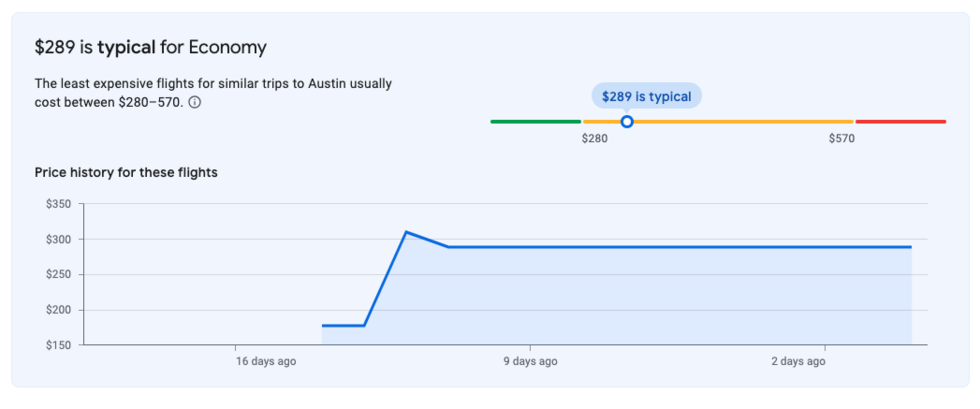 (Screenshot of Google Flights graphic showing typical airfare for a flight to Austin, Texas)
(Screenshot of Google Flights graphic showing typical airfare for a flight to Austin, Texas)
But what are you supposed to do with that information? Just because airfare is high doesn’t mean it’s going to drop. But, on the other hand, it might—after all, airfare is notoriously volatile.
The site’s new tool is designed to predict where prices might be headed, based on the history of fares for certain routes.
Let’s say we're booking a trip for November from Washington, D.C., to St. Thomas in the U.S. Virgin Islands.
As we enter dates, not only does airfare pop up, but check out the disclaimer at the bottom of the screen.
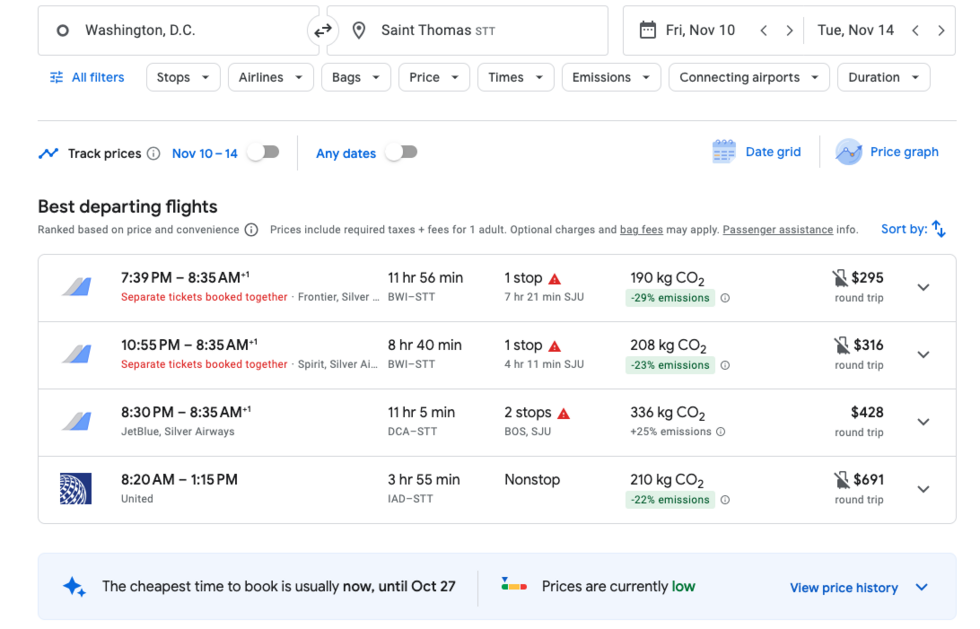 (Screenshot of Google Flights airfares for flights from Washington, D.C., to the U.S. Virgin Islands)
(Screenshot of Google Flights airfares for flights from Washington, D.C., to the U.S. Virgin Islands)
According to the last line on the screen, prices are "currently low" and the "cheapest time to book is usually now, until October 27." Remarkably, the latter date is just 14 days before the departure date we set.
You can enlarge the price history section for a bit more information, and you'll find that, according to Google's data, the least expensive airfare for “similar trips” to St. Thomas usually is found 1 to 3 months prior to takeoff.
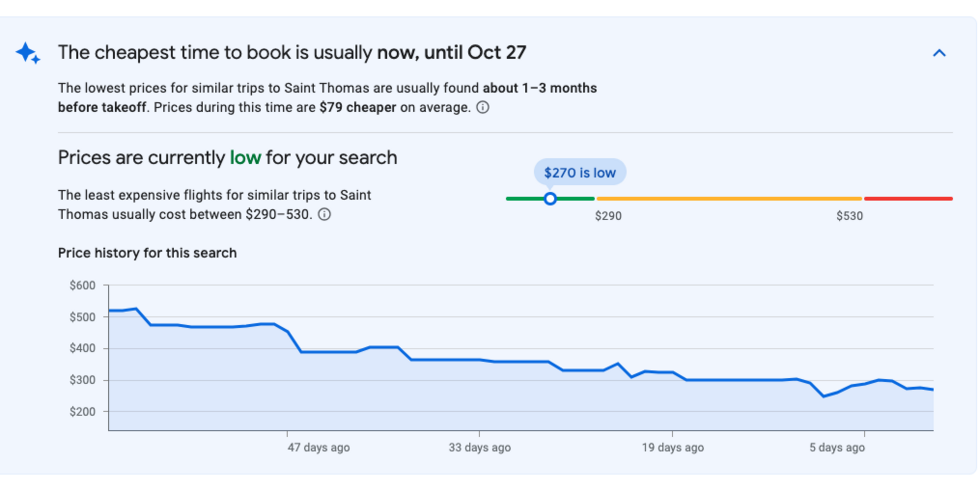 (Screenshot of Google Flights data on the cheapest time to book a flight to St. Thomas, USVI)
(Screenshot of Google Flights data on the cheapest time to book a flight to St. Thomas, USVI)
So, if you're comfortable relying on Google's data, you can feel pretty confident about booking this flight now, knowing you're getting a comparatively low fare.
Of course, in order for the service to be truly effective, it must also advise travelers on when they should wait to book an airfare that's currently high but expected to go lower.
Here’s an example we found for a summer 2024 trip from Los Angeles to London. Obviously, we’d be the early bird in booking this ticket, which right now would go for $1,089 round trip, per Google Flights.
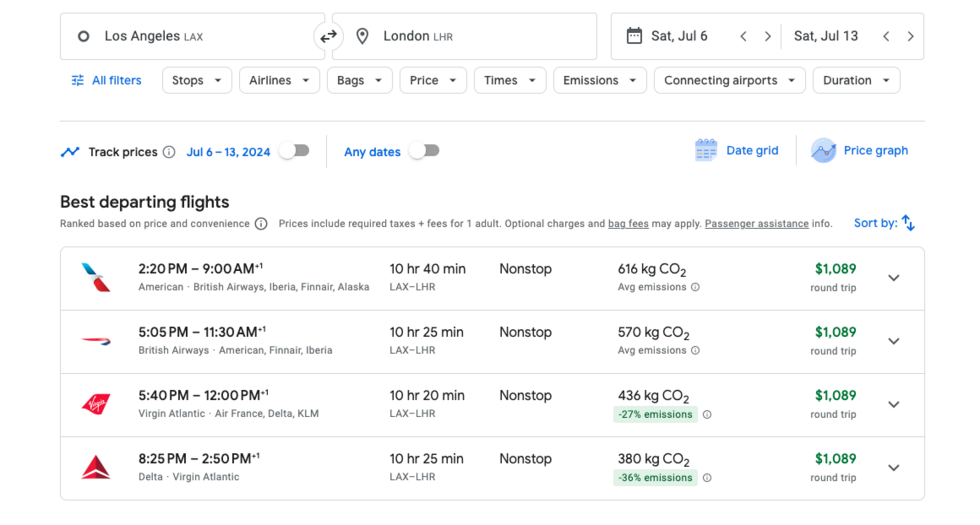 (Screenshot of summer 2024 airfares for Los Angeles to London from Google Flights)
(Screenshot of summer 2024 airfares for Los Angeles to London from Google Flights)
Google Flights says you’d be better off waiting, though. How long?
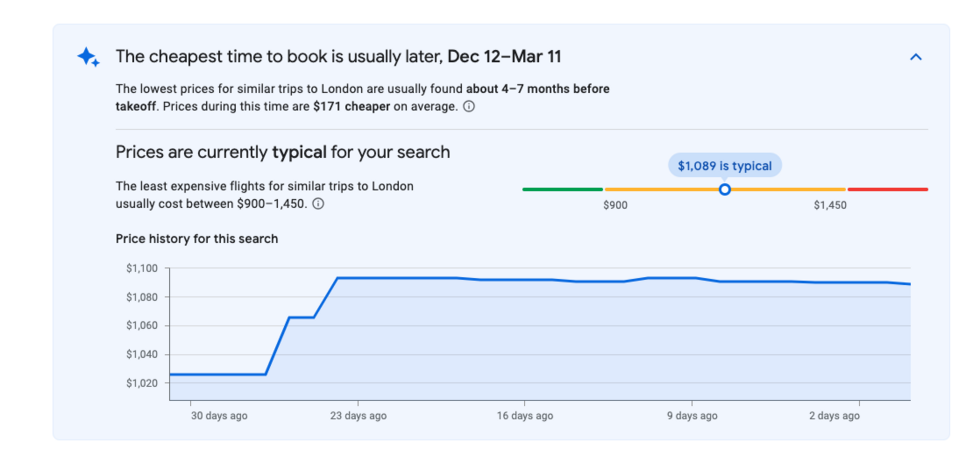 (Screenshot of Google Flights data on when to book a flight from Los Angeles to London)
(Screenshot of Google Flights data on when to book a flight from Los Angeles to London)
The cheapest time to book, Google Flights found, is typically between December 12 and March 11 (or 4 to 7 months before departure), when you can expect prices to be about $171 cheaper on average.
In a case like this, you might want to avoid booking the flight now, and instead turn on Google’s price alert emails so you can closely monitor fare fluctuations.
The downside
Unfortunately, Google does not have the same level of data available for every route and itinerary. Right now, the company says it’s only offering the new timing tool for searches “with reliable trend data.”
We found many, many search results where Google did not offer advice on whether to book.
For instance, Google Flights notes that the $395 price tag for this spring trip from Los Angeles to Los Cabos, Mexico, is “high” for an economy ticket, and the search engine supplies the “typical” range for such an itinerary.
However, Google doesn’t offer a suggestion on when might be a better time to book the flight.
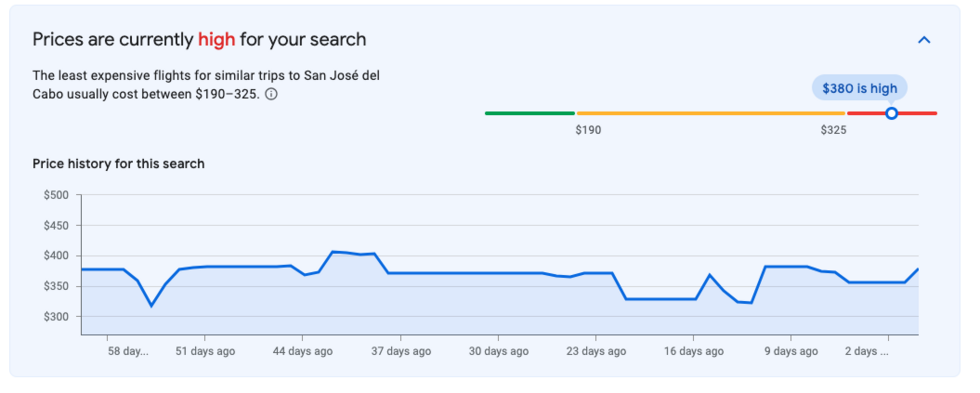 (Screenshot of Google Flights pricing data for a flight from Los Angeles to Los Cabos, Mexico)
(Screenshot of Google Flights pricing data for a flight from Los Angeles to Los Cabos, Mexico)
That said, Google Flights does provide some general guidelines related to timing. The company suggests booking domestic flights (outside of peak summer and holiday periods) between 54 and 78 days ahead of departure to get the lowest average prices.
For Europe, Google says your best bet is 72 days out or more.
Kayak’s Best Time to Travel tool
Earlier this summer, Kayak rolled out its own "Best Time to Travel" tool.
Via the new feature the online travel agency will, first, help you find the cheapest month, week, and days to fly, then will recommend whether to book your travel now or later.
Let’s say we’re taking a hypothetical trip from New York City to London’s Heathrow Airport. You’ll start by plugging in those cities and airports at Kayak.
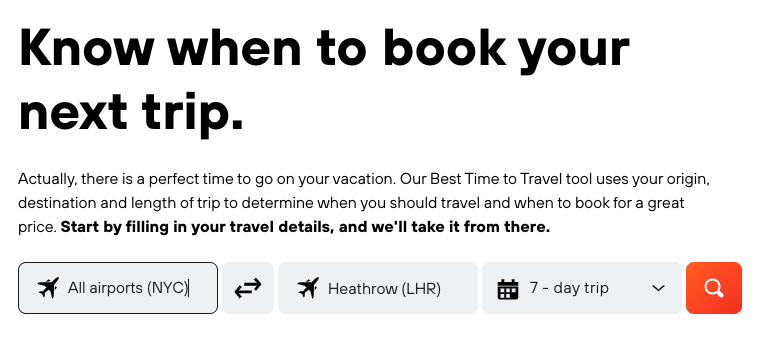 (Screenshot of flight search using Kayak's Best Time to Travel tool)
(Screenshot of flight search using Kayak's Best Time to Travel tool)
Kayak then tells us that February is the cheapest upcoming month for travel to London.
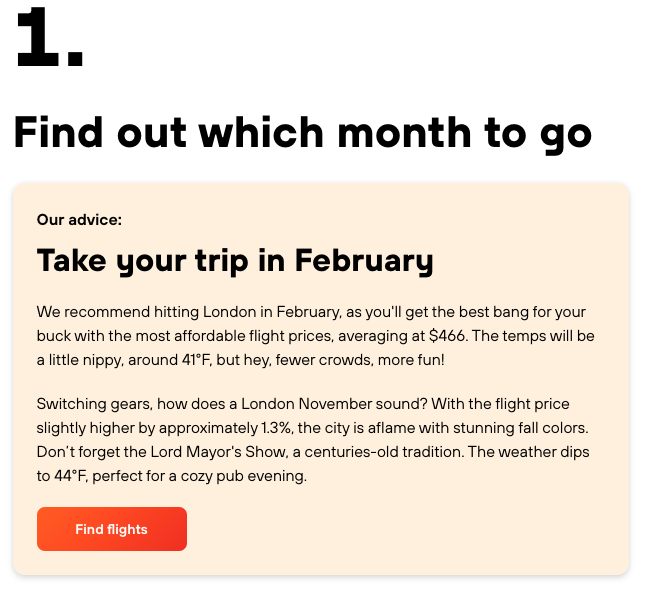 (Screenshot of flight timing advice from Kayak)
(Screenshot of flight timing advice from Kayak)
However, let’s say you'd prefer to go in March for an early spring trip. To do this, Kayak needs you to "nail down your dates."
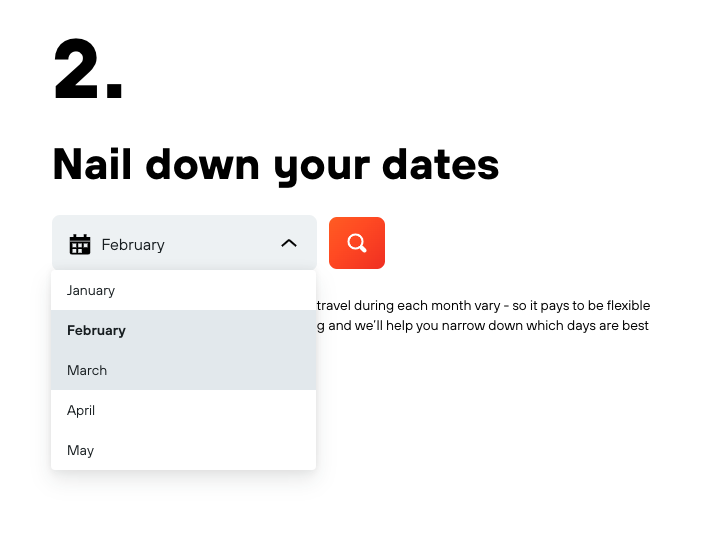 (Screenshot of Kayak's "nail down your dates" feature for timing flights)
(Screenshot of Kayak's "nail down your dates" feature for timing flights)
Kayak then displays some March price trends, and recommends the cheapest days to fly that month, based on that data.
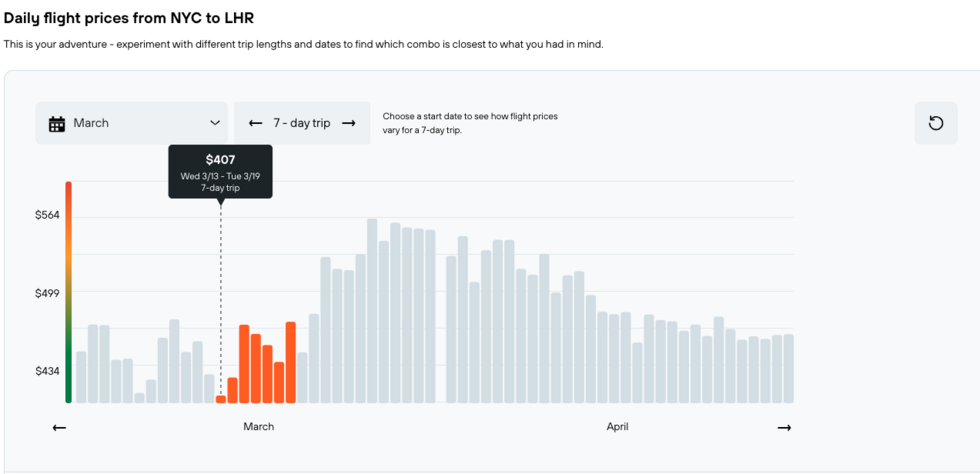 (Screenshot of Kayak's March price trends for flights from New York City to London)
(Screenshot of Kayak's March price trends for flights from New York City to London)
Once the dates are set, flight itineraries will pop up. In this scenario, the cheapest option appears to be aboard Virgin Atlantic for $429, round trip.
 (Screenshot of flight options from Kayak)
(Screenshot of flight options from Kayak)
While the flight options load, so does Kayak’s recommendation on whether to book now or wait. In this case, Kayak recommends booking now based on its analysis that fares are “unlikely to decrease within 7 days.”
![]() (Screenshot of "buy now" recommendation from Kayak)
(Screenshot of "buy now" recommendation from Kayak)
The downside
During our test searches of many different itineraries, it wasn’t clear whether Kayak’s recommendations to “buy now” are based on data that takes into account periods beyond the next 7 days. Could the fare go down in, say, 2 or 3 weeks? Or a couple months from now?
We reached out to Kayak, and a company rep confirmed that the tool does indeed only evaluate the next 7 days. Obviously, that’s a significant limitation for far-out flights.
The Kayak rep told us the company is working on an update to the tool for holiday bookings; that update is expected to launch in the coming days—though it’s not clear whether the tool will make when-to-book recommendations for the holidays based on data beyond a 7-day period, either.
What's more, across numerous searches we were not able to find any examples of Kayak recommending that we wait to purchase a flight. The site didn't tell us to "buy now" every time, however; in many cases we got a disclaimer saying Kayak is "still gathering data" for a particular route.
Takeaways on new flight timing tools
Having tried out these new products from Google Flights and Kayak, we've gathered some key takeaways to keep in mind when booking flights.
Google Flights vs. Kayak
Google Flights’ “when to book” product appears to get more specific with date ranges and trend data on when you should book—provided Google has data for the route and itinerary you're interested in. As of this writing, a lot of routes still don't have what Google calls "reliable trend data" allowing the new tool to give specific recommendations on the best time to book a flight to get the cheapest fare. So in many flight searches, users will have to rely on more generalized suggestions when it comes to timing flight purchases.
Compared to Google Flights, Kayak seems to offer booking advice for a wider (though certainly not a complete) range of itineraries. But Kayak's timing recommendations are based on an evaluation of data for the next 7 days only, which obviously presents limitations for trips planned far in advance. Plus, we had a difficult time finding examples of cases in which Kayak actually recommends waiting to book a flight, raising questions about the tool's usefulness. (Admittedly, our searches were undertaken during the early autumn, when fares do tend to be lower overall.)
It’s not an exact science
Airfare experts caution that these tools, while helpful, are not perfect since they attempt to forecast pricing for something that can fluctuate from one day—or even one hour—to the next.
“These tools are definitely handy, especially for somebody that doesn’t travel often,” said Katy Nastro, spokesperson and travel expert at Going (formerly Scott’s Cheap Flights).
If you're unfamiliar with the ups and downs that airfares are subject to, you might welcome some data-driven assistance. But as you become a more seasoned traveler, Nastro says, you'll want to regard the advice as "a guideline, not a definitive.”
She sees these tools as additional sources of information travelers can have at their disposal as they decide whether—and when—to book.
Check these tools, but book directly with the airline
For that reason, it may be worth checking your itinerary on both Google Flights and Kayak to see whether they say it's a good time to book, then go compare prices on the airline website.
Booking directly with the airline is sometimes cheaper and can present fewer obstacles if you need to make an itinerary change later on.
And don’t forget: If you do decide to book and later find a better deal, there are often ways to cancel and rebook at a lower price.





